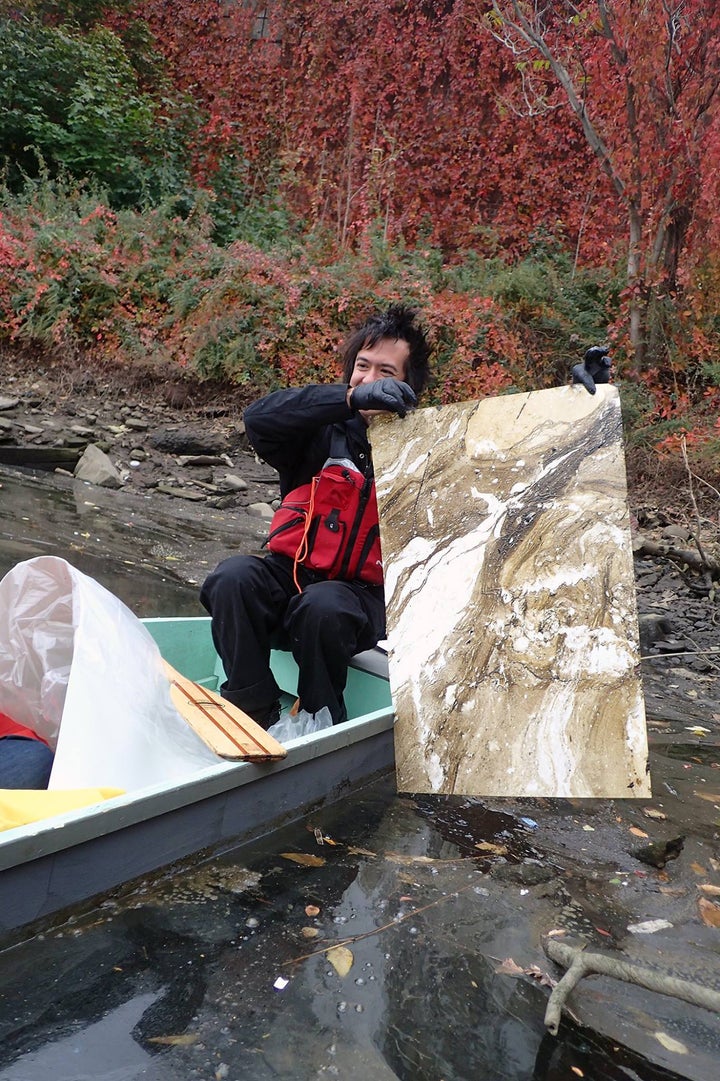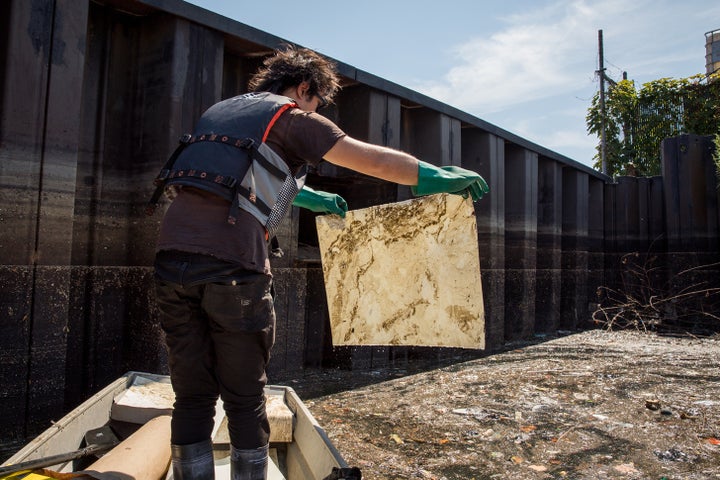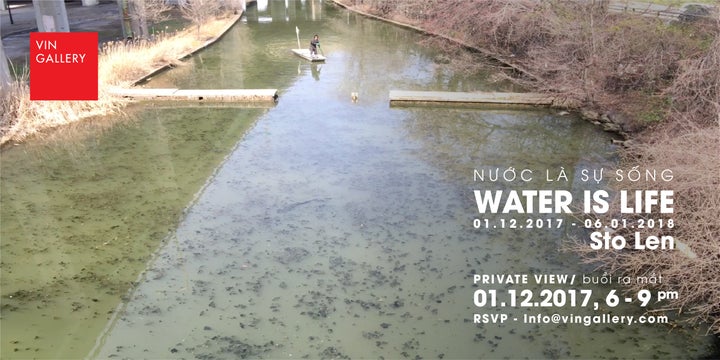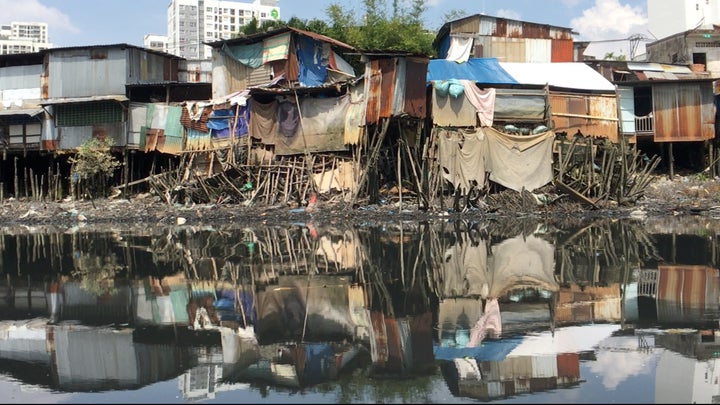This interview was originally published on my blog Against Nature which is about the environment and the social effects of climate change. Go there to read more in depth interviews with the people who are thinking, planning, and fighting for our very existence on this planet.

print made by artist Sto Len in Flushing Meadows, New York City.
Over the past couple of years, I’ve made a point to attend the New York Art Book Fair at PS1 MoMA, and to try find weird and exotic zines. This year I came across a zine by an artist named Sto Len at the Cinders Gallery booth that really caught my attention.
Sto makes these beautiful prints out of the super-polluted Newtown Creek water in Greenpoint, Brooklyn in New York. Like Sto, I live near the creek, so it’s an active interest of mine. Recently I’ve read Geoffrey Cobb’s brilliant history of the neighborhood; Greenpoint Brooklyn’s Forgotten Past which covers 150 years of industrial dumping by petroleum refineries, copper, gas, paint, varnish, assorted chemical companies and raw sewage. Newtown Creek is a designated Superfund site since 2010 and is supported by ExxonMobil for environmental crimes dating back to their previous corporate incarnation as Standard Oil.
I interviewed Sto through email while he’s been travelling about southeast Asia on an artist residency. We discussed him boating around Newtown Creek, polluted waterways abroad and of course art. You can find his work here.

Sto pulling a pollution suminagashi print from a polluted waterway.
Michael Lee Nirenberg: We have a shared interest in our own backyard Superfund site Newtown Creek which is in Greenpoint Brooklyn. When did you start doing work over there and how?
Sto Len: Well, I guess it started when I first moved to Greenpoint back in 2000. I was mostly hanging out at the Williamsburg waterfront, which was completely wild and abandoned then, and it has that incredible view of Manhattan. When cops started busting people down there a few years later, the Newtown Creek became my go-to spot because there was never anyone there! So, it was just my secret hangout zone for a long time and I became fond of the area.
Around 2011, I began working with a printmaking process called suminagashi which involves painting on water with ink. You basically make a floating painting and then you lay paper on the surface to capture the image when it’s done. I became obsessed with this idea of collaborating with water and allowing nature to have its way with my mark making. I was buying the biggest inflatable swimming pools I could find and making these floating paintings with ink, oil paint, enamel, dirt, whatever I could get to float. One day it sort of dawned on me that I was essentially making oil spills in my studio – what if I went to a real one and used it instead of paint? Over the years I had definitely seen some nasty stuff floating in the Newtown and I had known about the Greenpoint Oil spill for a long time. I did some printing from the shore and it totally worked!
My friend Marie Lorenz is an artist who has a project called Tide and Current Taxi, which is about taking people on boat rides, and she took me out one day with her homemade boat and let me print, and it was a great feeling. She showed me how relatively easy it was to launch a boat from a few access points and a couple weeks later I bought a rowboat on craigslist for $100. I began going out pretty regularly around 2015 and I loved gaining access to all of these new spaces with a boat. I also loved being outside all day and making prints instead of being stuck indoors. My art practice was evolving as was my knowledge of the Creek and its history. Spending more time down there has definitely given me a new perspective on the city, and seeing firsthand just how bad the water is, was enlightening, to say the least.
MN: That’s an interesting process. Were you at all nervous about tipping over into the superfund netherworlds of the creek?

courtesy of Sto Len
SL: Yeah for sure – I’m super careful! And knock on wood, I’ve never fallen in. There are some comical moments though where I’m balancing on the edge of the boat and pulling out a giant, wet, toxic print and its flapping in the wind and I’m trying not to get any of it on me. I must look a bit ridiculous.
MN: Just to be clear, when we look at a suminagashi print from say the Newtown Creek for example, we are looking at a mixture of both an ink process AND river gunk?
SL: No, I’m JUST using river gunk – there is no ink! It’s all done at the site, on the actual water, similar to what I’ve been doing in the studio but I don’t add anything later. I find the proper surface and I may use a brush or a stick to help to create the composition out of the sludge but the end result is exactly what the water looked like in that moment. I often feel like I’m developing a photo, putting my paper into this chemical bath, and pulling it out to dry. And then I see what I’ve got afterwards.
MN: In an email you told me about a recent trip to Columbia where you were researching the polluted river that goes through Medellin. Tell me about the work you were doing there.
SL: I was doing a residency at a space called Casa Tres Patios and I was researching Rio Medellin, a 37 mile river that runs right through the center of the city. I didn’t know much before going there and then just hit the ground literally running along the river and exploring. It was fascinating because there were some similarities to the Newtown in that it is practically invisible to a lot of people. When I have shown my Newtown Creek prints in the past, many people have not known what or where the Newtown is, even people living in Greenpoint! I get a lot of people asking me if it’s the Gowanus Canal, but the Newtown is like the lesser known but more toxic little brother.
Rio Medellin is known but mostly ignored. It’s like the member of the family that has too many problems so you just don’t even talk about it, you don’t even wanna look at it! It was once a naturally flowing river that you could swim, fish and hang out near. After it was channelized in the 1950s and a highway was built alongside it, public access was mostly blocked and it essentially was left to rot, turning into a smelly sewer where large homeless encampments now exist.
People are living under the bridges and in the tunnels, bathing and washing their clothes in the contaminated water, and everyone else just avoids going down there. It’s actually not that easy to get to. I found myself running across the highway, climbing fences, and going under bridges to get to it. But just like the Newtown, there are these tranquil, beautiful moments down there that I just wish the public could see or experience in a safe manner. And it should not be ignored! Medellin is a picturesque city that lies in a valley with foggy mountains all around. It is known for its violent past but there has been a big push to change that perception, which seems mostly positive. But it’s this idea about what is “progress” that is troubling. Is it progress to look the other way when factories dump toxic waste into your river because they will pay you millions in fines? There is actually a street called La Playa (the beach) that was a lovely waterway and the city paved over it so they could build more roads. Now there is a whole homeless community living under La Playa too.
I mainly took photos and video of these areas to give them some visibility but I plan to go back and work with some like-minded folks I met who will help me organize some site-specific interventions. I want to throw a punk show down there with some local bands I met, serve free food, set up a pirate radio station and create an inviting space for people to hang out, children, families, everyone, an attempt at allowing people to see some possibilities with these neglected spaces. And then maybe the city will try harder to clean the water, who knows? It looks like chocolate milk, it’s pretty bad. I’m starting to realize that a lot of my work is about urban neglect and its effects. I’m also realizing that these issues are all pretty global and when it comes to clean water, it’s so urgent!
MN: That’s an ambitious project for the people of the Rio Medellin. What is their government like? Are there any cleanup efforts of any kind planned regarding the river?
SL: The government is definitely working on cleaning up the river but I still hear complaints from locals about corruption and slow-moving plans. I believe there is a new water treatment plant being built in the area called Bello but the river will always be a channelized canal and it won’t be able to return to its former glory unfortunately. That said, I talked with a lot of people who thought it was still important for the public’s idea of the river to change and I agree. It’s such a large area right in the middle of the city and it seems like a waste if it isn’t used by more people. Maybe I can help a little with that part. When a friend in Medellin shared my video about the river on Facebook, it spawned tons of conversation from locals and that was awesome to see!
MN: What do you think the people you spoke to meant when they said, “it was important for the public’s idea of the river to change”? I’m also curious about what their economy is like? Does the river support the people there in anyway?
SL: Well, I think people meant that the public’s main idea of the river is that it’s dirty and gross but since it’s the only water around, people just associate all of their local water as a hopelessly foul area and that’s not good. People need to think that there is hope for change to actually happen. If you have some hope, you will litter less and you will go down to the water to hang out sometimes. You might even go around picking up trash or checking in on the state of the homeless camps. I don’t think it’s a river that local people make money off of even though people do fish occasionally, hopefully for sport but probably also for dinner.
MN: You mentioned that next up is work in Vietnam. Is that going to be along the same lines of environmental waterways studies?
SL: Yeah I’m here in Saigon right now for a month and a half. I have a solo exhibition at Vin Gallery that is focusing on the “black canals” of Ho Chi Minh City. I’ve been spending a lot of time in the most polluted areas of the city and it’s been super intense and emotional to see it firsthand.

I’m half-Vietnamese, my mom is Saigonese, but we were never able to come here when I was growing up. The past couple years I’ve been coming to visit and just hang out. I met a lot of great people and got excited about everything happening here right now. I was asked to do an exhibition in Hanoi last year at a cool space called Manzi and I ended up doing some printing in one of the local lakes. Some of those were in my show and then a crazy thing happened: a day after my opening there was a massive fish death in that same lake! 60 tons of fish floated belly up and it was the most insane thing I’ve ever seen. Word got around that I had printed from that same body of water earlier that week and so lots of people came to see the prints and talk to me, which was really cool. It created a dialogue with a lot of different types of people about pollution and illegal dumping, as well as the effect on the local economy that heavily relies on fishing.
There was a news report on TV about my show and I was going around showing it to fishermen and trying to see what they thought. Vietnam is an incredibly beautiful, magical country and it pains me to see so much pollution happening. The black water, the mounds of trash along the shores, the stilt houses that are on top of these waters that smell so bad – people shouldn’t be living like this. But yeah, I’m hanging out in those zones, making prints, filming, taking pics, and trying to talk to locals about it all. For my show, I’m going to have prints that I made here in the water and I’ll set up a pseudo-Vietnamese style funeral for the water. It’s not quite dead yet but I want to stress that it feels like it’s dying and we got to save it before it’s too late!
MN: That’s fucking incredible man. What killed the fish exactly and why all at once? I think it’s interesting that they were so receptive to your work there. I’m guessing art has a social function there in contrast to here where it’s mostly an economic driver.
SL: Well, no one really knows for sure. The media says it was lack of oxygen but some people don’t believe that. The news is heavily censored here. There have been other proven instances of toxic substances being dumped in the water by large companies that also created massive fish deaths. Some very intense protests have happened because of that and many arrests too, it’s a touchy subject here, but a very important one. I hope that people can speak more openly about it in the future because we have to address these things, even if it is not pretty or easy to deal with.
I think a lot of artists do think about their work in a socially political way here, even if it’s not necessarily overt. You can’t say or do certain things here so the work has to be a bit more subtle, which can make it more inventive and less obvious actually. The art scene is not super big so it’s definitely a different vibe from NY, not as commercial and still growing in a natural way. Yeah, it’s a bit sad that you feel art is mostly driven by economics in the US but I guess it is true for many people in “the art world.” It’s business, it’s selling pretty objects that go well in people’s living rooms. I like beautiful objects but I want some content too, something challenging and thought provoking, something I haven’t seen before. There’s a lot of irony in American art and retro ideas, things are starting to look the same to me because trends catch on so quickly now, and they lose their power when they become so accessible. I get excited by art that has a different worldview than what I’m used to in the US, work that seems to come from an original, sincere place and isn’t trying too hard to be hip or clever.
MN: I think that’s an accurate reading of “the art world” here in New York. For an economy that relies so heavily on ideas, it’s ironic that there’s such a herd mentality. That’s one of the many reasons I’ve lost interest in it over the years and why what you’re doing is interesting to me.
That aside, I saw a video on your Instagram page this morning where you’re floating on a boat along the Ho Chi Minh River and you see these patched together, tin huts in this extremely polluted river. Total abject poverty. These are important images for Americans to see in this age of unprecedented deregulation of environmental safeguards by a corrupt EPA and a weirdly anti-science president. What do you think it’s going to take to depoliticize the environment? I’m asking everyone because I take a dim view that people will only care when their lives are destroyed by climate change or pollution which generally only happens to poor minority communities.

SL: Uh, yeah, I think it will, unfortunately, take a big disaster that they are affected by to really wake people up in America. Or maybe a government that actually tells them the truth. When people don’t have clean water anymore they will freak out and it won’t be pretty. But of course there are profits to be made, right? So who cares about the future. When our current administration pretends climate change is a hoax in order to make more money off of fossil fuels, you have a lot of people just going with what they say. Of course, poorer communities will be the first to feel it, whether they are Trump supporters or not, it doesn’t matter, it will get to everyone eventually, even the rich. It will be our final demise for sure. Haha, I’m actually a very optimistic person but I’m also realistic. I obviously do think it’s important to continually try to get people to understand the gravity of climate change and showing them what it looks like is one way. People need to realize that they play a part in all of it and can make a difference with their daily actions. I think if we make it economic – if people know they can make money or save money by being more green, it could have an impact. We should all try to be active in educating others in our own way with the tools that we have available. ___________________
MN: Where are you from? Were you always interested in the environment?
SL: I’m from Virginia. I grew up in the DC area and so the government was omnipresent, everything was political, and my parents were both social workers. Luckily for me, the art museums were free and the DC punk scene was amazing. I started going to shows when I was like 13 and seeing Fugazi play in front of the White House with Bikini Kill kinda changed everything. Art and activism naturally go hand in hand to me because I saw it that way early on in my life. I’ve always been interested in the environment but not always sure what to do, it can be hard. When I was younger I tried working for Greenpeace but that wasn’t for me. They made me go canvassing, showing up at people’s doors at dinnertime – I got a lot of doors slammed in my face haha! I hated that type of work but I think I’m finding a good way to work on my own terms that combine various interests that I’m passionate about.
MN: I think that’s a difficult line to ride for any artist who is concerned with the world. One of the solutions I came to was starting this blog. Are you based in New York mostly?
SL: NY has been my home base for the past 17 years and it’s as much a part of me growing up as Virginia was. I learned so much in NY and still do sometimes. I have a great home/studio zone right now but I’ve also been actively trying to do work in other places, more so than ever before. I feel like it’s really important for artists, for anyone, to do that as much as humanly possible. I’m learning so much by going way outside of my bubble, getting super lost and then figuring it out. You inch forward somehow, little by little, the ideas widen I think. I guess I’ve always loved the idea of touring like a band but not the part where you leave after one night. My version is you stay at least a month in that town and do a residency, make work and maybe have an exhibition or a performance, a night of sharing before you go. Things happen with your work that wouldn’t back home and I love those surprises, those happy accidents- I embrace them.
MN: What is the performance aspect of your work like?
SL: I do performances with sound and movement usually. Improvised sonic sculpting with basic means. I wear contact mic-ed gloves and interact with everyday objects, pulling sound from them and using a few effect pedals to give them variation. It’s a kind of stripped-down practice for me these days, almost ritualistic, a daily meditation. It’s a fun project to work on in new places because I gather things as I travel that I think will have some type of sonic potential and try them out, layering sounds, touching things, learning the best way to sing into a tree branch or a plastic stool. In Medellin, I hand picked objects that I knew would have a resonance with locals and it was cool to hear people’s reactions, the way they bring their own experience into it. That’s a big part for me too, giving relevance to objects one might overlook normally or not think of as an instrument. All of a sudden they are thinking about dirty water and the environment too. I like sort of sneaking in this dialogue too of course.
